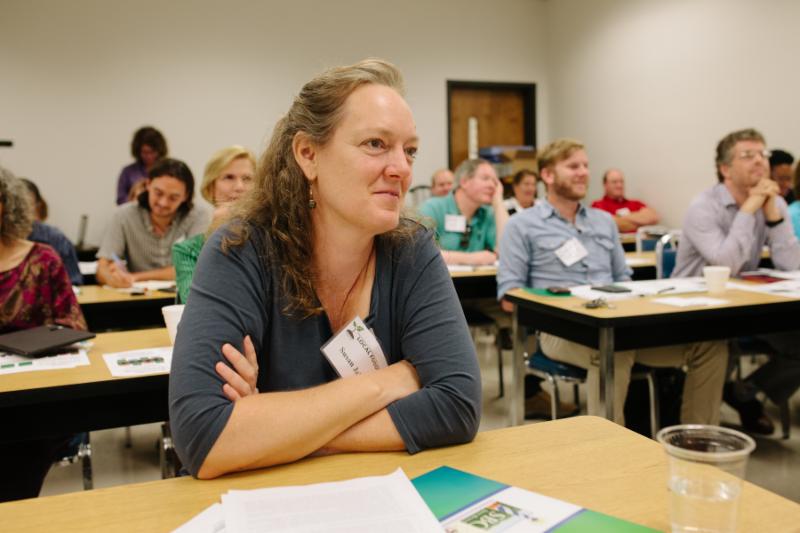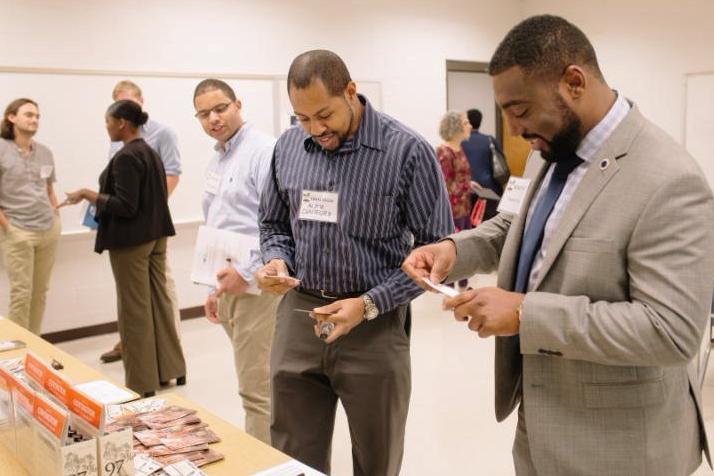The following article is from North Carolina Growing Together (NCGT), a five-year (2013-2017) USDA-funded CEFS initiative that is working to bring more locally-grown foods – produce, meat, dairy, and seafood – into mainstream retail and food service supply chains. For more information about NC Growing Together, please visit www.ncgrowingtogether.org or read their October 2017 newsletter.
Local Food Economies, a project of CEFS’ NC Growing Together initiative, engages local and regional governments in the work of building local food systems. In September, Local Food Economies and the NC 10% Campaign organized three Innovations in Economic Development through Local Foods gatherings to showcase investments that local and regional governments can make to support small and mid-scale food and farming businesses. These events were attended by officials from over 46 local, regional, and state government agencies in 89 of North Carolina’s 100 counties.
“The goal of these events was to inform decision-makers and planners in local and regional government about how local agriculture is successful as an economic development driver,” said Laura Lauffer, Project Coordinator, Local Farms and Food, N.C. A&T State University Cooperative Extension Program and NC Growing Together.
 Each of the filled-to-capacity events – held in Waynesville, Ellerbe, and Henderson – highlighted successful examples from around the state of local governments supporting local food and farm businesses. There were networking opportunities with representatives from the North Carolina Department of Agriculture and Consumer Services, the North Carolina Rural Center, North Carolina Department of Commerce Rural Planning Division, and the Economic Development Partnership of North Carolina. The American Institute of Certified Planners (AICP) offered Certification Maintenance credits to its members who attended.
Each of the filled-to-capacity events – held in Waynesville, Ellerbe, and Henderson – highlighted successful examples from around the state of local governments supporting local food and farm businesses. There were networking opportunities with representatives from the North Carolina Department of Agriculture and Consumer Services, the North Carolina Rural Center, North Carolina Department of Commerce Rural Planning Division, and the Economic Development Partnership of North Carolina. The American Institute of Certified Planners (AICP) offered Certification Maintenance credits to its members who attended.
Local Food Economies’ outreach has helped bring food and farm business development to the economic development agendas of North Carolina’s county and municipal governments. Nine of the sixteen regional Councils of Government now include agricultural economic development as a goal of their comprehensive plans.
Don Belk, a Community Economic Development Planner with the Rural Economic Development Division of the North Carolina Department of Commerce, attended the gathering at Vance-Granville Community College in Henderson. “This was a great networking experience for me. As the planner for North Carolina’s ‘North Central Prosperity Zone’, this introduced me to the dedicated individuals and innovative efforts going on in the area,” he said.
 “One of the more interesting things I learned was that we as a state are still struggling to build the local foods ‘infrastructure’ needed to really expand opportunities for farmers and greater, economical food options for citizens. Here is where regional collaboration is vital. We need to look at the local food infrastructure and the agricultural capacity of the land at the regional scale to determine what is needed,” he added.
“One of the more interesting things I learned was that we as a state are still struggling to build the local foods ‘infrastructure’ needed to really expand opportunities for farmers and greater, economical food options for citizens. Here is where regional collaboration is vital. We need to look at the local food infrastructure and the agricultural capacity of the land at the regional scale to determine what is needed,” he added.
All of the presentations from the Innovations in Economic Development events can be found on YouTube, here.
NC Growing Together and Local Food Economies has created a suite of resources to support local government engagement in local food systems development. Visit the Local Food Economies website for County Agriculture Infographics, Local Food Economic Development Videos, and A Government Guide on Building Local Food Economies. The new GIS version of NCGT’s Local Food Infrastructure Inventory Map can be found here.
 This material is based upon work that is supported by the National Institute of Food and Agriculture, U.S. Department of Agriculture, under award number 2013-68004-20363. Any opinions, findings, conclusions, or recommendations expressed are those of the author(s) and do not necessarily reflect the view of the U.S. Department of Agriculture.
This material is based upon work that is supported by the National Institute of Food and Agriculture, U.S. Department of Agriculture, under award number 2013-68004-20363. Any opinions, findings, conclusions, or recommendations expressed are those of the author(s) and do not necessarily reflect the view of the U.S. Department of Agriculture.


